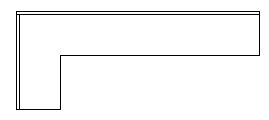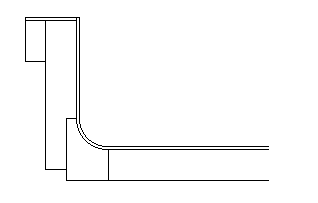 Design Watch: Cove: A 3/4" radius cove is used for these tops in adjacent, non-seamed or mitered splash designs. Deck seams are only necessary when overall size (including the splash) exceeds the largest available laminate sheet size. Mitered seams or butt joints are only needed when the top would not be installable in one piece. Rigid Glue: Compared to the standard contact cement, a top using rigid glue is superior in applied edge designs, and designs that include laminate seams.
The cove support is milled to fit behind the cove for strength and support. The rigid glue bonds the laminate to the cove "stick" which is keyed into the backsplash. This is part of the reason why these are the best quality, custom-made countertops that can be made with plastic laminate. |
Other Terms:Cove Rolled, Adjacent Cove Description: The laminate extends across the deck and continuously rolls up the face of the splash. Usually the top of the splash is square. "L"; shaped and "U" shaped tops can usually be fabricated without miters, and often without any deck seams at all. Mather uses a rigid set adhesive in fabricating most of these tops resulting in superior bonding, tighter seams, longer life and performance. Variations: Front edge can either be flat laminate
(Self Edge Rolled Cove) or have a bevel laminate, solid surface, wood, etc. applied to it
(Applied Edge Rolled Cove). Applications: These tops are excellent for almost all applications, particularly when sinks are part of the function. For kitchen, lab, or vanity tops there is quite probably no better plastic laminate top. |
